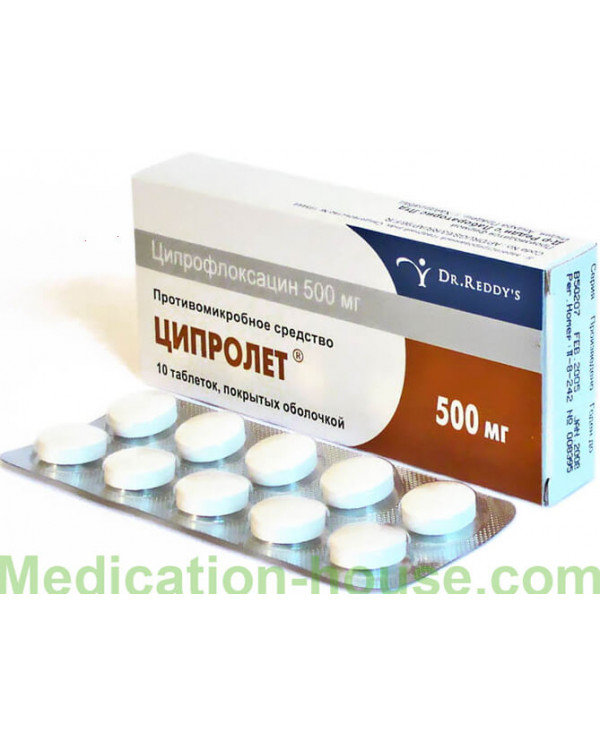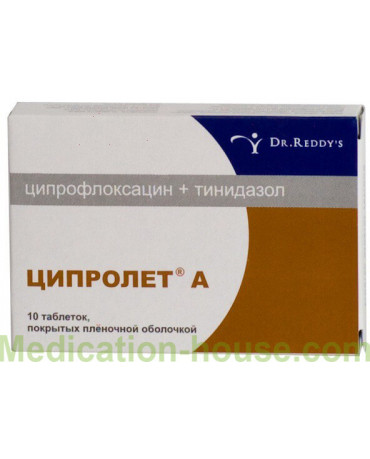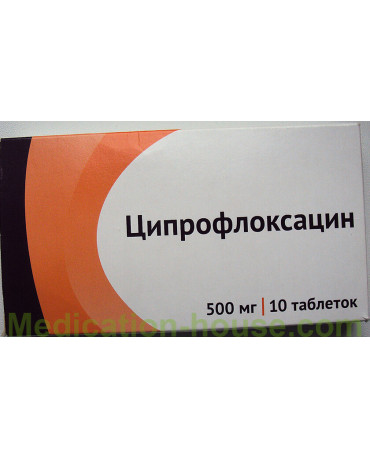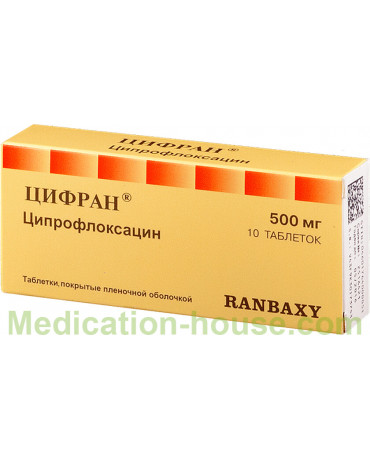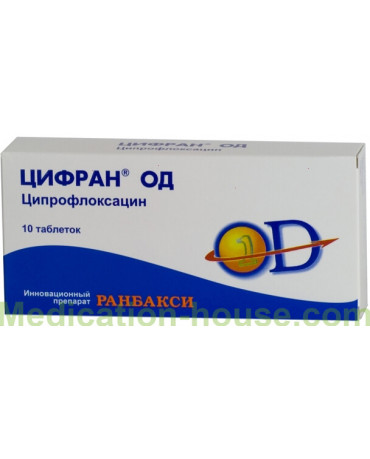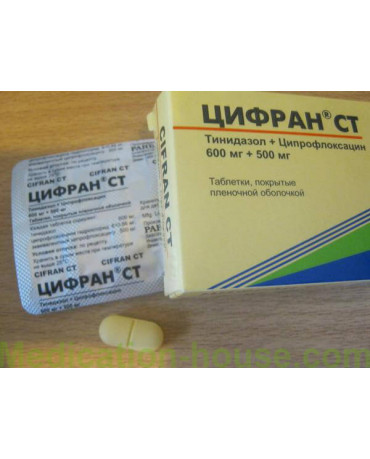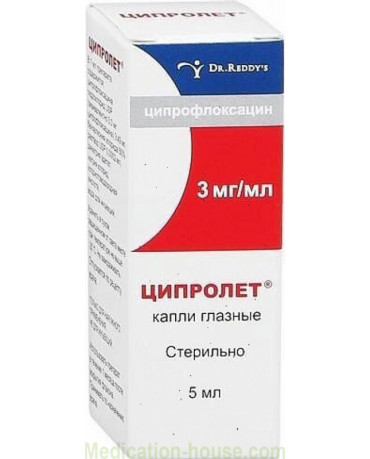Ciprolet instruction
You can buy Ciprolet here
It is recommended in the fight against the manifestations of both positive and gram-negative microorganisms. It is useful in that, unlike similar means, it does not destroy the balance of the microflora of the intestinal tract, the vaginal area. Recommended drug to get rid of ailments caused by bacteria.
The effectiveness of Ciprolet is confirmed in a number of clinical trials. So, in one of them the clinical efficacy of the drug in the treatment of chronic infectious and inflammatory diseases of the urogenital tract, caused by mixed microflora, was 90%. At the same time, Ciprolet was well tolerated: side effects were mild and appeared in 8.5% of study participants.
Composition and release form
Tablets for oral administration. Sold in blisters of 10 pieces. In packing 1 or 2 blisters.
The composition of 1 tablet includes:
Active substance: ciprofloxacin - 250 or 500 mg (as ciprofloxacin hydrochloride monohydrate - 291.106 or 582.211 mg, respectively);
Auxiliary components (250/500 mg, respectively): corn starch - 50.323 / 27.789 mg; microcrystalline cellulose - 7,486 / 5 mg; talc - 5/6 mg; croscarmellose sodium - 10/20 mg; colloidal silicon dioxide - 5/5 mg; magnesium stearate - 3.514 / 4.5 mg;
Film casing (250/500 mg, respectively): Polysorbate 80 - 0.08 / 0.072 mg; hypromellose (6 cps) - 4.8 / 5 mg; titanium dioxide - 2 / 1,784 mg; sorbic acid - 0.08 / 0.072 mg; macrogol 6000 - 1.36 / 1.216 mg; talc - 1.6 / 1.784 mg; Dimethicone - 0.08 / 0.072 mg.
Pharmacological effect
The antiprotozoal and antimicrobial effects of the combined drug Ciprolet A are manifested due to the effects of its two active ingredients.
Imidazole derivative - tinidazole - is an antiprotozoal and antimicrobial drug with high lipophilicity, due to which it easily penetrates into the simplest organisms and anaerobic bacteria, where the intracellular synthesis is inhibited and the structure of their DNA is damaged. Tinidazole is harmful for the causative agents of trichomoniasis, giardiasis, amebiasis, and microorganisms that cause anaerobic infections: Clostridia, Bacteroids, Eubacteria, Fuzobacterium, Peptococci, Peptostreptokokki.
Fluoroquinolone derivative - ciprofloxacin - is characterized by broad antimicrobial efficacy. It has an overwhelming effect on the II and IV topoisomerases of the DNA gyrase of microorganisms, which are responsible for the supercoiling of the DNA of chromosomes around the RNA of the nucleus, which is indispensable for deciphering genetic information. It prevents the division and growth of bacteria, the synthesis of DNA, leads to pronounced changes in intracellular morphology (including its membranes and walls), which together cause their death.
Bactericidal efficacy is directed to gram-negative microorganisms at the stage of their division and dormancy (due to lysis of the cell walls), and to gram-positive bacteria only at the stage of their division. Ciprofloxacin has a low toxicity to the cells of the microorganism due to the absence of DNA gyrase in them. In its use, parallel production of resistance to other antibacterial agents that are not inhibitors of gyrase is not observed, which is reflected in the high efficacy of the drug against bacteria that resist the effects of aminoglycosides, cephalosporins, penicillins, tetracyclines and many other groups of antibiotics.
The use of ciprofloxacin is fatal for aerobic gram-negative microorganisms - enterobacteria (Salmonella, Escherichia coli, Shigella, Klebsiella, Proteus, Enterebacter, Serratia, Edwardsiel, Hafnium, Morganella, Iersinius, Vibrio). Other Gram-negative bacteria (Pseudomonads, Hemophilus bacilli, Moraksell, Pasterell, Aeromonas, Campylobacter, Neusseria). Some intracellular pathogens (Legionella, Listeria, Brucella, Mcobacterium) and representatives of aerobic gram-positive bacteria (Streptococcus and Staphylococcus).
In the case when staphylococcus is resistant to methicillin, they are most often resistant to ciprofloxacin, however, this resistance is formed very slowly due to the fact that microorganisms do not produce enzymes that inactivate the drug and due to their extremely small amount remaining after exposure.
Indications for use
The use of Ciprolet in the form of tablets and solution is indicated for the treatment of infectious and inflammatory diseases caused by microorganisms sensitive to ciprofloxacin, including:
infections of the musculoskeletal system;
infections of the mucous membranes, skin and soft tissues;
postpartum infections;
infections of the teeth, mouth, jaws, gastrointestinal tract;
ear, nose and throat infections;
respiratory tract infections;
infections of the gallbladder and biliary tract;
infections of the kidneys and urinary tract;
genital infections (prostatitis, gonorrhea, adnexitis);
sepsis;
peritonitis.
In addition, tablets and solution are used as part of complex therapy with immunosuppressants in the prevention and treatment of infections in patients with reduced immunity.
Contraindications
Contraindications for taking Ciprolet are:
Hypersensitivity to ciprofloxacin, as well as other substances of the fluoroquinolone group.
Pregnancy and lactation.
Age up to 18 years, except as indicated in the indications for children.
Simultaneous reception with tizanidine.
Appointment during pregnancy and lactation
Accurate data during clinical studies on the effect on the unborn child, the mother's body is not. Nursing and women in the position of the drug is contraindicated to exclude negative consequences.
Dosage and method of use
As indicated in the instructions for use tablets are taken orally, on an empty stomach (before meals), drinking a sufficient amount of liquid.
The doctor prescribes the dose and period of treatment individually on the basis of clinical indications, taking into account the type of infection, comorbidities, the severity of the condition, the age and weight of the patient.
Recommended dosing regimen:
infections of the kidneys and urinary tract: uncomplicated form - 250 mg, severe form - 500 mg, frequency of use - 2 times a day;
lower respiratory tract infections: moderate form - 250 mg, severe - 500 mg, frequency of use - 2 times a day;
gonorrhea: 250–500 mg once;
severe forms of enteritis, colitis and gynecological infections (occurring with high fever), osteomyelitis, prostatitis: 500 mg 2 times a day;
normal diarrhea: 250 mg 2 times a day.
The duration of treatment is 7–10 days, after the complete disappearance of the symptoms of the disease, the pill must be taken a few more days.
In case of severe impaired renal function, the dose of the drug is reduced by 2 times.
In chronic renal failure, the dose depends on creatinine clearance (CK):
QC above 50 ml / min: normal dose;
CC 30–50 ml / min: 250–500 mg 1 time per 12 hours;
CC 5–29 ml / min: 250–500 mg 1 time per 18 hours;
dialysis: 250–500 mg 1 time per 24 hours after hemodialysis or peritoneal dialysis.
Adverse reactions
During the use of Ciprolet inside and intravenously, the following side effects may develop:
Sense organs: hearing loss, tinnitus, impaired sense of smell and taste, visual impairment (diplopia, change in color perception);
Laboratory indicators: hypercreatininemia, hypoprothrombinemia, hyperglycemia, hyperbilirubinemia;
Allergic reactions: scabbing of small nodules and blisters, accompanied by bleeding, pruritus, drug fever, urticaria, punctate hemorrhages (petechiae), vasculitis, laryngeal or facial edema, eosinophilia, dyspnea, increased photosensitivity, erythema, erythema, ectinophilia, eosinophilia, shortness of breath, increased photosensitivity, erythema, erythema, ectinophilia, eosinophilia, shortness of breath, increased photosensitivity, erythema, erythema, ectinophilia, eosinophilia, shortness of breath, increased photosensitivity, erythema, erythema, ectinophilia, eosinophilia, shortness of breath, increased photosensitivity, erythema, erythema, ectinophilia, eosinophilia; epidermal necrolysis (Lyell's syndrome), Stevens-Johnson syndrome (malignant exudative erythema);
Cardiovascular system: cardiac arrhythmias, tachycardia, lowering blood pressure, rush of blood to the skin of the face;
Urinary system: interstitial nephritis, hematuria, crystalluria (primarily with low diuresis and alkaline urine), glomerulonephritis, polyuria, dysuria, albuminuria, urinary retention, urethral hemorrhages, a decrease in the nitrogen-secreting kidney function;
Musculoskeletal system: tendon ruptures, arthralgia, tendovaginitis, arthritis, myalgia;
Blood system: thrombocytosis, granulocytopenia, leukopenia, thrombocytopenia, anemia, leukocytosis, hemolytic anemia;
Digestive system: anorexia, abdominal pain, nausea, vomiting, diarrhea, flatulence, cholestatic jaundice (especially in patients with previous liver diseases), hepatonecrosis, hepatitis, increased activity of hepatic transaminases and alkaline phosphatase;
Nervous system: headache, dizziness, tremor, fatigue, insomnia, nightmares, peripheral paralgesia (abnormal perception of pain), increased intracranial pressure, sweating, anxiety, depression, confusion, hallucinations, and other manifestations of psychotic reactions (occasionally they can progress to conditions in which the patient is capable of harming himself), syncope, migraine, cerebral artery thrombosis;
Other: general weakness, superinfection (candidiasis, pseudomembranous colitis).
Overdose
First of all, overdose affects the condition of the kidneys and provokes acute renal failure. In addition, overdosing can cause dizziness, convulsions, hallucinations, abdominal discomfort, changes in consciousness.
special instructions for Ciprolet
Before you start using the drug, read the specific instructions:
During the period of treatment should avoid contact with direct sunlight.
During the period of treatment it is necessary to provide a sufficient amount of fluid while observing normal diuresis.
Patients with epilepsy, bouts of convulsions in history, vascular diseases and organic brain damage due to the threat of adverse reactions from the CNS Ciprolet should be appointed only for health reasons.
If severe or prolonged diarrhea occurs during or after treatment with Ciprolet, the diagnosis of pseudomembranous colitis should be excluded, which requires immediate discontinuation of the drug and appropriate treatment.
In the event of pain in the tendons or the appearance of the first signs of tendovaginitis, treatment should be discontinued due to the fact that isolated cases of inflammation and even rupture of the tendons during treatment with fluoroquinolones are described.
Compatibility with other drugs
When using the drug, you must consider the interaction with other drugs:
With simultaneous use of Ciprolet and anticoagulants, bleeding time is extended.
With simultaneous use of Ciprolet and cyclosporin, the nephrotoxic effect of the latter is enhanced.
With simultaneous use of Ciprolet with didanosine, the absorption of ciprofloxacin is reduced due to the formation of ciprofloxacin complexes with aluminum and magnesium salts contained in didanosine.
Simultaneous use of Ciprolet and theophylline can lead to an increase in plasma concentration of theophylline, due to competitive inhibition in the binding sites of cytochrome P450, which leads to an increase in theophylline T1 / 2 and an increased risk of toxic effect associated with theophylline.
Simultaneous administration of antacids, as well as preparations containing ions of aluminum, zinc, iron, or magnesium, may cause a decrease in the absorption of ciprofloxacin, therefore the interval between administration of these drugs must be at least 4 hours.
Reviews
We offer you to read the reviews of people who used Ciprolet:
Azamat
Ciprolet 500mg. In the morning and in the evening. After it immediately hilak forte drops-in a glass of water-35 drops. Then all sorts of furatsillin, lugol and adzhisept. It is in this sequence. When purulent tonsillitis doctor prescribed me.
Vika
You need to be very careful with this medicine. The doctor prescribed Ciprolet from cystitis, although it seemed that spring was and experienced winter without incident, but the first spring breeze blew up the problem. And with him there is another one ... Since no one said that taking this remedy can not be in the sun for a long time, as a result, I also earned photodermatitis, a dermatologist made this diagnosis after I went through both a therapist and an allergist. Just an intelligent doctor got caught and said that from some drugs, including from Ciprolet.
Tatyana
Ciprolet took repeatedly, almost every year once a year is necessary. The fact is that I already have been suffering from chronic bronchitis for five years (after suffering a disease on my legs). In the autumn-winter season after hypothermia (or maybe catching an infection), sometimes the strongest cough begins, which does not go away for a long time. Lately, in such cases I have already assigned myself Ciprolet. I try to drink all seven days, twice 250 mg. Usually it becomes easier for 3-4 days, but I do not stop drinking the drug. Whether from a painful condition, or a reaction to the drug, but the appetite disappears, trouble from the gastrointestinal tract. Then everything is normalized.
Terms of sell
You don't need a prescription to buy Ciprolet.

